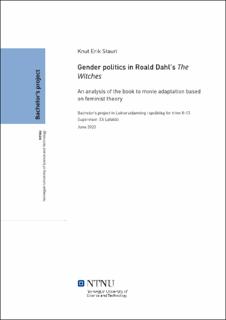| dc.description.abstract | The purpose of the thesis is to compare aspects of the novel and the movie The Witches by
Roald Dahl. More specifically, I am investigating the gender politics in both the movie and
the movie, seeking to spot differences in the portrayal of females and women as witches in
these works. Dahl explains the phenomenon of witches early in this children’s book,
emphasizing the great distinction between women and witches. He explains that witches are
not human beings, but demons disguised as women. Despite this clear and intelligible
explanation, the novel was met with mixed reception. Several libraries around the world
considered the book to cause misogyny, due to its presentation of women as horrifying
witches seeking to put an end to the existence of children.
Did Roald Dahl’s portrayal of witches bring implications to society’s perception of
women and gender equality? Is The Witches an arena for acquiring basic misconceptions of
women at a young age? These questions have formed the basis of the thesis, leading to the
development of a thesis statement.
By using critical feminist theory, I sought to discuss and compare the gender politics
in the novel and the movie. I found that it is challenging to conclude the gender politics in
The Witches. There are some differences in the portrayal of women in the novel and the
movie, and one may argue that aspects of them could cause misogyny, while other aspects
could be supporting feminism. | |
